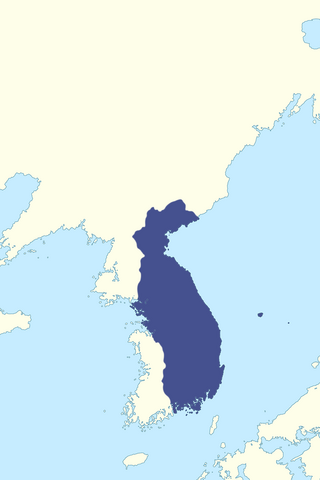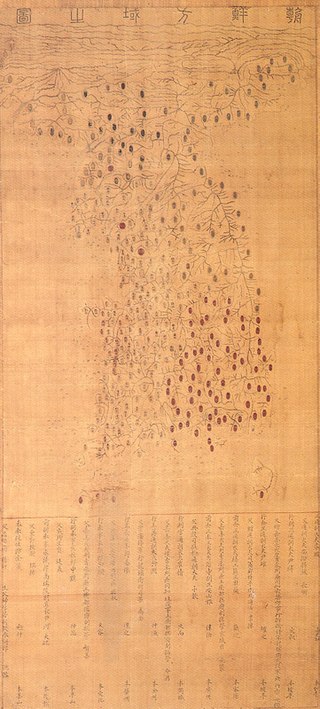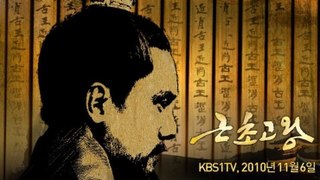Korea's provinces have been the primary administrative division of Korea since the mid Goryeo (Koryo) dynasty in the early 11th century, and were preceded by provincial-level divisions dating back to Unified Silla and Balhae during the Northern and Southern States period, in the 7th century.

The Three Kingdoms of Korea or Samhan competed for hegemony over the Korean Peninsula during the ancient period of Korean history. During the Three Kingdoms period, many states and statelets consolidated until, after Buyeo was annexed in 494 and Gaya was annexed in 562, only three remained on the Korean Peninsula: Goguryeo, Baekje and Silla. The "Korean Three Kingdoms" contributed to what would become Korea; and the Goguryeo, Baekje and Silla peoples became the Korean people.

Silla, alternatively Shilla, was a Korean kingdom that existed between 57 BCE – 935 CE and located on the southern and central parts of the Korean Peninsula. Silla, along with Baekje and Goguryeo, formed the Three Kingdoms of Korea. Silla had the lowest population of approximately 850,000 people, which was significantly smaller than those of Baekje and Goguryeo.

Jeolla Province was one of the historical Eight Provinces of Korea during the Kingdom of Joseon in southwestern Korea. It consisted of the modern South Korean provinces of North Jeolla, South Jeolla and Gwangju Metropolitan City as well as Jeju Province. The provincial capital was Jeonju, the current capital of North Jeolla. The entire inland region was called Honam, which is still commonly used today.

Chungcheong was one of the eight provinces of Korea during the Joseon Dynasty. Chungcheong was located in the southwest of Korea. The provincial capital was located at Gongju, which had been the capital of the kingdom of Baekje from 475 to 538. The cities who were on former province will host the 2027 Summer World University Games.

Gongju is a city in South Chungcheong province, South Korea.

Wiryeseong was the name of two early capitals of Baekje, one of the Three Kingdoms of Korea. Both are believed to have been in the modern-day Seoul area. According to Samguk Sagi, Onjo, the son of Goguryeo's founder Jumong, founded the nation of Sipje on Wiryeseong in 18 BC, while his elder brother Biryu established himself in Michuhol further to the west. The location of Michuhol is usually believed to be present-day Incheon.
Jeonji of Baekje was the eighteenth king of Baekje, one of the Three Kingdoms of Korea.
Achasanseong Fortress is an earthen mountain fortress dating from the Korean Three Kingdoms period. Originally built by Baekje, it was occupied in turn by each of the Three Kingdoms. It stands on Achasan Mountain, in Gwangjin-gu, Seoul, South Korea, at an altitude of 200 meters above sea level. It has a perimeter of roughly 1 kilometer and an area of about 3375 m².
Munju of Baekje was the 22nd king of Baekje, one of the Three Kingdoms of Korea. His reign saw considerable disunity within Baekje following the fall of its capital in present-day Seoul.

The history of Seoul can be traced back as far as 18 BC, although humans have occupied the area now known as Seoul since the Paleolithic Age. It has been the capital of numerous kingdoms on the Korean Peninsula since it was established.

Songpa-gu is a district of Seoul, South Korea. Previously known as Wiryeseong, the first capital of the kingdom of Baekje, Songpa is located in the southeastern part of Seoul. With roughly 647,000 residents, Songpa is also the largest district in Seoul by population.

Korea has had a number of capitals. Korea is a peninsula in East Asia, currently the peninsula is divided into two countries: North Korea's capital is Pyongyang, and South Korea's capital is Seoul.

Seoul, the capital of South Korea, has been called by a number of formal and informal names over time.

Seoul, officially Seoul Special City, serves as the capital of South Korea, and is its most extensive urban center. The broader Seoul Capital Area, encompassing Gyeonggi province and Incheon metropolitan city, emerged as the world's fourth largest metropolitan economy in 2014, trailing only Tokyo, New York City, and Los Angeles, hosting more than half of South Korea's population. Although Seoul's population peaked at slightly over 10 million, it has gradually decreased since 2014, standing at approximately 9.97 million residents as of 2020. Seoul is the seat of the South Korean government.
Shinsen Shōjiroku is an imperially commissioned Japanese genealogical record. Thirty volumes in length, it was compiled under the order of Emperor Saga by his brother, the Imperial Prince Manta. Also by Fujiwara no Otsugu and Fujiwara no Sonohito et al. It was initially completed in 814, but underwent a revision to be re-completed in 815.

The King of Legend is a 2010 South Korean historical drama based on King Geunchogo of Baekje. Besides historical information from Samguk Sagi and Samguk Yusa, it was also inspired by a novel written by Lee Munyeol, a renowned Korean writer. The drama aired on KBS1 in Korea, and internationally through KBS World.

The Baekje Historic Areas are a group of monuments located in three South Korean cities: Gongju, Buyeo, and Iksan. They relate to the last period of the Baekje Kingdom, representing the period from 475 to 660 CE, which was one of the three kingdoms that flourished from 18 BC to 660 CE. The property designated as a UNESCO World Heritage Site has eight archaeological sites. These are: The Gongsanseong fortress and the royal tombs at Songsan-ri, related to the capital city of Ungjin, now Gongju; the Busosanseong Fortress and Gwanbuk-ri administrative buildings, the Jeongnimsa Temple, the Neungsan-ri royal tombs, and the Naseong city wall in Sabi, now Buyeo; and the Wanggung-ri Palace and the Mireuksa Temple in Iksan, a subsidiary capital region of Sabi.

The Seoul Lantern Festival is a festival held every winter in Seoul in South Korea. It includes lanterns, outdoor light installations, christmas market, experience programs.
Creation myth of Baekje is the creation story of Baekje dynasty about Onjo, the first king of the Baejke Dynasty, and Biryu, his elder brother. They were the princes of the Buyeo dynasty, but were not a crown prince. Thus they left Buyeo to establish their own country. Finally, Onjo founded Baekje dynasty.
















